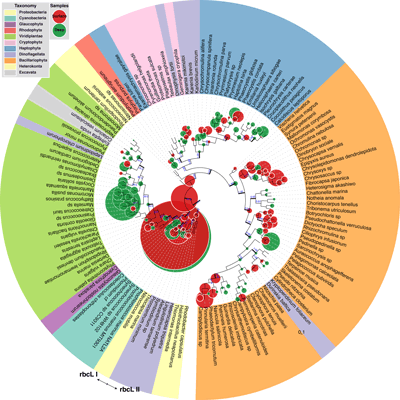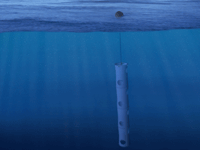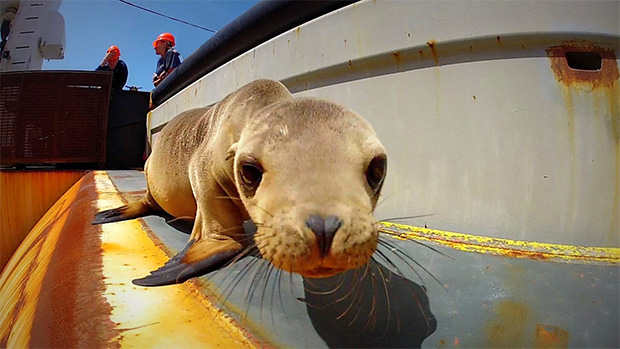NOAA CalCOFI Genomics Project (NCOG): a NOAA-JCVI-SIO Partnership (PDF)
Pilot Study on Microbial Biogeography Diversity and Gene Expression in the Southern California Bight
Microbial diversity and function represents one of the great data gaps in marine observations, despite the fact that microbes underpin the function of the earth’s biosphere and serve as indicators of ocean change. Together viruses, bacteria, and protists account for most of the organic carbon contained within biological entities are crucial components of coastal and pelagic ecosystems. 97% of the organic carbon in the ocean biosphere is found in the dissolved phase and the origin and fate of this important reservoir is dictated by microbial activity. Marine food web dynamics and associated carbon, nitrogen, silica and other key ocean ecosystem nutrient cycles are largely regulated by microbial activity. Therefore our ability to conceptualize and model ocean processes is predicated in large part on our understanding of microbial processes and interactions.
Samples suitable for DNA and RNA analyses will be collected for studies examining the diversity, biogeography, and activity of planktonic microbes. DNA samples, collected in conjunction with particulate organic carbon and nitrogen (POC/PON) samples (http://cce.lternet.edu/data/methods-manual/augmented-cruises/particulate-organic-carbon-nitrogen), through the California Current Ecosystem Long Term Ecological Research project (CCE-LTER), at 66 CalCOFI and 9 SCCOOS sites at three to eight depths each, will be used to assay the diversity and distribution of microbes and other planktonic organisms. POC and PON measurements provide information on the spatial and temporal variability, and relative carbon:nitrogen (C:N) ratio, of the standing crop of biomass in the CCE. By linking analyses of microbial community and structure and diversity directly to measurements of ecosystem productivity we will be able to evaluate microbial population and community dynamics in the context of other indictors of ecosystem productivity.
RNA samples, collected in conjunction with Primary Productivity stations and CCE-LTER Cardinal stations (Figure 1; line 80 and line 90 stations selected to represent different floral regimes) (http://www.calcofi.com/field-work/station-work.html) will be used to examine patterns of gene expression in virioplankton, bacterioplankton and phytoplankton (Figure 2). In order to evaluate linkages between processes occurring in the surface layer and deeper in the water column, each cardinal station is also sampled in the mesopelagic at 515m and, when possible, two stations (one in the northern and one in the southern region of the sampling grid) will be sampled from the bathypelagic zone at 3500m.
The CalCOFI region encompasses a biogeographic boundary that is highly susceptible to multiple stressors, including expanding ocean hypoxia, ocean acidification, ocean warming and increased density stratification, harmful algal blooms, overfishing, and increased acoustic pollution from shipping traffic. Understanding and predicting the impacts of these combined stressors is critical to the economic stability and resiliency of the region; it is the preferred spawning site for ~90% of epipelagic fish biomass in the southern California Current System, as well as for many nearshore fishes and benthic invertebrates. Many of the stresses impacting the CCE are caused, mediated or directly impacted by microbes and this project aims to enhance our knowledge regarding the sensitivity of microbial processes to relevant disturbances.
DNA and RNA sequencing of rDNA and mRNA respectively, and associated bioinformatics, will be used to elucidate the diversity and functional activity of microbes within the context of physical and chemical perturbations in the southern CCE (1) (Figure 2). This unique perspective may unearth critical information regarding ocean response to large-scale pressures, enabling us to better predict tipping points and augment our understanding of factors that enable or dampen and ecosystem resiliency.
Scientific & Programmatic Points of Contact:
NOAA-OAR: Kelly Goodwin (AOML; stationed at SWFSC)/Margot Bohan (OER)
NOAA-NMFS: Andrew Thompson / Cisco Werner (SWFSC)
J. Craig Venter Institute: Andrew Allen
UC San Diego-Scripps Institute of Oceanography (SIO): Dave Checkley/Ralfe Goericke/ Andrew Allen
Project Lead: Andrew Allen, This email address is being protected from spambots. You need JavaScript enabled to view it.
 |
| (click image for higher resolution pdf) |
Figure 1. Sampling sites for the CalCOFI NCOG project. Cardinal stations (located on lines 80 and 90), bathypelagic sampling stations and primary production stations are shown from the April 2014 cruise. Primary production experiments are conducted each day shortly before local apparent noon (LAN) and as a result stations may vary slightly between cruises. Also shown are Spray glider lines deployed along Lines 80 and 90 and the CCE-1 and CCE-2 moorings (line 80) which together provide high spatial resolution sections of physical and biological data along these sampling lines to a depth of 500m.
 |
 |
| (click image for higher resolution pdf) | |
Figure 2. A,B) A fluorescence section plot across line 90 from the April 2014 cruise illustrating relative biomass and location of the chlorophyll maximum layer. Green and red dots indicate locations of mRNA samples obtained in conjunction with Cardinal and primary productivity stations respectively. C) Phylogenetic placement of RuBisCO sequences recovered from total mRNA sequencing applied to surface and subsurface chlorophyll maximum samples (SCM) collected along CalCOFI line 93 in July 2007 (2). RuBisCO large subunit (rbcL) maximum likelihood tree with phylogenetic placement of 2,631 metatranscriptome derived open reading frames. Bootstrap support values are shown when ≥ 50%. Thick branches indicate bootstrap support ≥ 90%. Bubble sizes are proportion to the average of the rarefied abundances of the surface and DCM samples.
- Allen, L.Z., Allen, E.A., Badger, J.H., McCrow, J.P., Paulsen, I.T., Elbourne, L.D.H., Thiagarajan, M., Rusch, D.B., Nealson, K.H., Williamson, S.J., Venter, J.C., Allen, A.E. Influence of nutrients and currents on the genomic composition of microbes across an upwelling mosaic. ISME Journal. Published online January 26, 2012. DOI:10.1038/ismej.2011.201
- Dupont, C.L., Valas, R., McCrow, J.P., Moustafa, A., Walworth, N., U. Goodenaugh, U., Roth, R., Hogle, S., Bai, J. Johnson, Z., Mann, E., Palenik, B., Barbeau, K., Venter, J.C., Allen, A.E. (2014) Genomes and gene expression across light and productivity gradients in eastern subtropical Pacific microbial communities.The ISME Journal. Advance online publication, 21 October, doi:10.1038/ismej.2014.198
 |
The Institute for Computational Earth System Science (ICESS) utilizes Pacific Gyre GPS/ Mobitex™ "Microstar" drifters to observe and study near-shore ocean circulation off the Southern California coast. The drifters record their position with GPS every 10 minutes and transmit their position data in near real-time to a web-based host computer using the Mobitex narrow band, data-only, cellular communications system. This sort of time and space resolution enables characteristic near-shore circulation patterns to be properly resolved. The drifters give direct observations of paths taken by freely floating objects at the ocean surface such as spilled oil, other pollutants, or things lost at sea.

